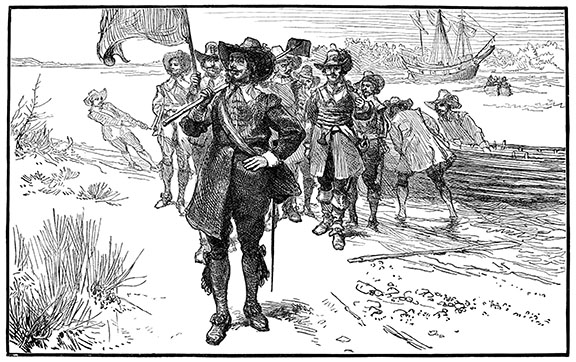
By JF Grodeska
New Jersey and New York have, at times, had a contentious relationship. It is usually the result of issues, like raising commuter taxes, determining which state can claim ownership of the Statue of Liberty, or that Staten Island secession movement.
In 1679, the governor of New York was former British Army Major Sir Edmond Andros, who was appointed by future King James II, then Duke of York. He was a brusque and humorless man who seemed to always be scheming about expanding his role in the Colonies. From his governor’s mansion in Manhattan, Andros decided he would take over all of New Jersey, making it part of New York and under his control.
New Jersey, in 1679, was in a state of chaos. As Sun Tzu said, “In the midst of chaos, there is also opportunity.” So, it was little wonder Andros had his eye on New Jersey.
In those days New Jersey was owned by absentee proprietors and divided into East Jersey and West Jersey. These owners collected rent from the settlers. There was seemingly constant contention between settlers and proprietors over land rights.
Andros announced proprietary governments in-valid and proclaimed East and West Jersey under his control. He issued edicts that all ships trading with New Jersey were to stop at the Port of New York and pay customs duties and he announced he would build a fortress at Sandy Hook to enforce his edict. Andros also said people who resisted would be declared traitors to the King and punished.
West Jersey was sparsely populated and easy for Andros to conquer. However, the residents of East Jersey and their elected Gov. Philip Carteret resisted Andros’ attempts.
From his residence in Elizabethtown (now Elizabeth) Carteret warned Sir Edmund Andros “not to molest me, nor the people under my charge.” He further stated that Jerseyans would fight “with our lives and fortunes, the people being resolved to live and die with the name of true Subjects and not Traitors.”
Andros, incensed at the resistance, made an expeditionary trip to Elizabethtown with a group of men armed with only their swords to demand Carteret surrender to him. In an attempt to ameliorate the situation, Carteret suggested they take their “disagreement” to the King. Andros stomped away fuming.
Once back in Manhattan, Andros swore out a warrant for Carteret’s arrest, had him dragged to Manhattan in the middle of the night and tossed in jail. Andros had no choice, because of the high profile of this action, but to hold a jury trial for Carteret. A Manhattan trial, with a Manhattan jury. What could go wrong?
Much to Andros’ fury, the jury found Carteret innocent of any crime and freed him. However, Andros did manage to have him stripped of his governorship and wrest control of East and West Jersey, a move that went badly for Sir Edmund.
The American Colonies fell under the auspices of the Duke of York who wasa dear friend of Sir Edmund Andros. But under pressure from prominent settlers, he declared that New York had no jurisdiction over New Jersey and Andros was called home. Carteret was reinstalled as governor of East Jersey.
James eventually became King of England and sent Andros back to the Colonies, this time to fill the role of Governor of the New England Colonies. In that position, Andros sought tomake New York and New Jersey part of his New England governorship. But in 1688, the people of England pulled King James II from the throne and Andros was arrested and sent back to England. And once again, New Jersey avoided being conquered.
A mere 99 years later, New Jersey became the third state to ratify the U.S. Constitution and the first to sign the Bill of Rights, becoming a state Dec. 18, 1787.
The article originally appeared in the January 26 – February 1, 2023 print edition of The Two River Times.















